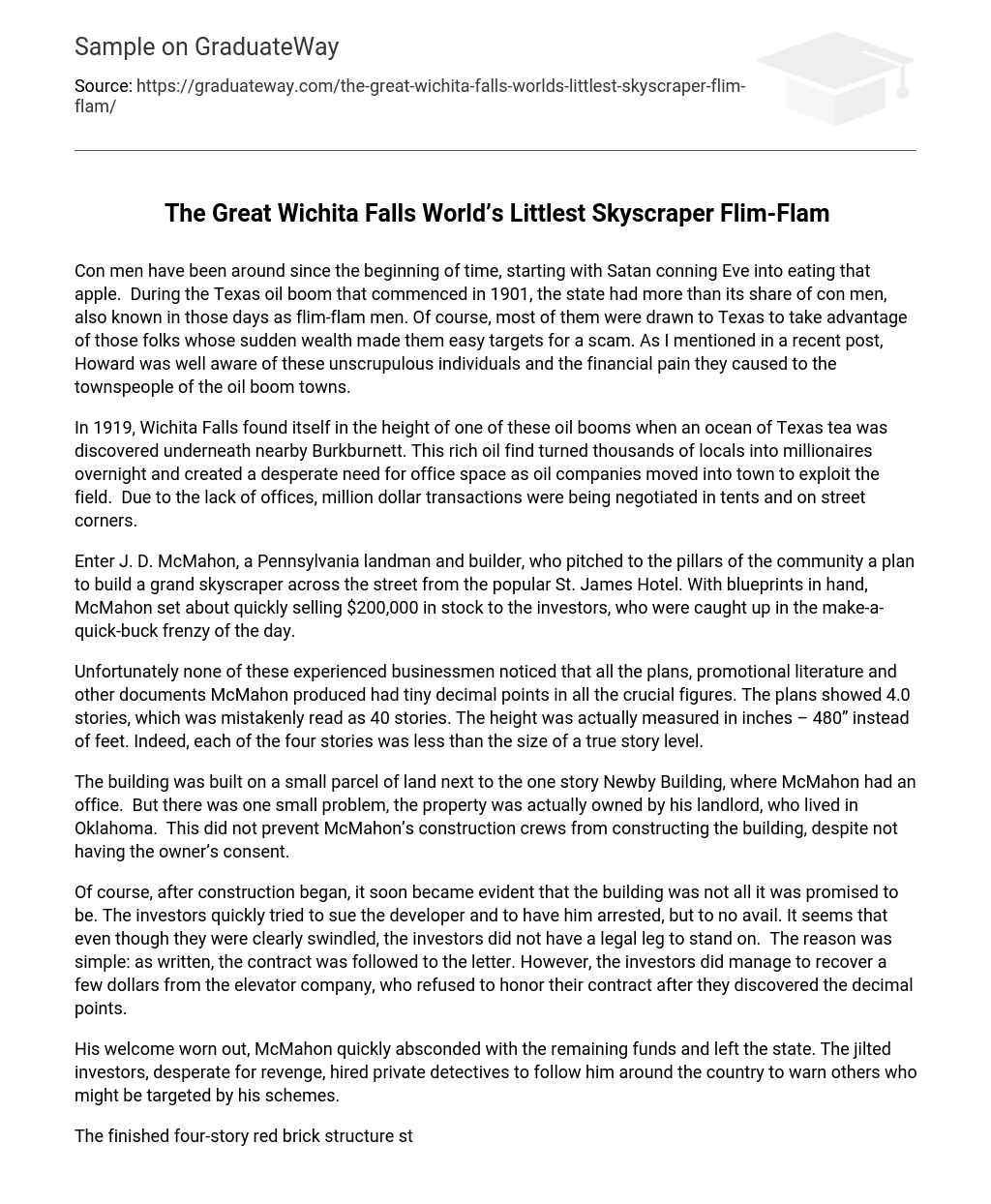Con men have been around since the beginning of time, starting with Satan conning Eve into eating that apple. During the Texas oil boom that commenced in 1901, the state had more than its share of con men, also known in those days as flim-flam men. Of course, most of them were drawn to Texas to take advantage of those folks whose sudden wealth made them easy targets for a scam. As I mentioned in a recent post, Howard was well aware of these unscrupulous individuals and the financial pain they caused to the townspeople of the oil boom towns.
In 1919, Wichita Falls found itself in the height of one of these oil booms when an ocean of Texas tea was discovered underneath nearby Burkburnett. This rich oil find turned thousands of locals into millionaires overnight and created a desperate need for office space as oil companies moved into town to exploit the field. Due to the lack of offices, million dollar transactions were being negotiated in tents and on street corners.
Enter J. D. McMahon, a Pennsylvania landman and builder, who pitched to the pillars of the community a plan to build a grand skyscraper across the street from the popular St. James Hotel. With blueprints in hand, McMahon set about quickly selling $200,000 in stock to the investors, who were caught up in the make-a-quick-buck frenzy of the day.
Unfortunately none of these experienced businessmen noticed that all the plans, promotional literature and other documents McMahon produced had tiny decimal points in all the crucial figures. The plans showed 4.0 stories, which was mistakenly read as 40 stories. The height was actually measured in inches – 480” instead of feet. Indeed, each of the four stories was less than the size of a true story level.
The building was built on a small parcel of land next to the one story Newby Building, where McMahon had an office. But there was one small problem, the property was actually owned by his landlord, who lived in Oklahoma. This did not prevent McMahon’s construction crews from constructing the building, despite not having the owner’s consent.
Of course, after construction began, it soon became evident that the building was not all it was promised to be. The investors quickly tried to sue the developer and to have him arrested, but to no avail. It seems that even though they were clearly swindled, the investors did not have a legal leg to stand on. The reason was simple: as written, the contract was followed to the letter. However, the investors did manage to recover a few dollars from the elevator company, who refused to honor their contract after they discovered the decimal points.
His welcome worn out, McMahon quickly absconded with the remaining funds and left the state. The jilted investors, desperate for revenge, hired private detectives to follow him around the country to warn others who might be targeted by his schemes.
The finished four-story red brick structure stood just 40 feet tall and each floor a paltry 118 square feet, with stairwells that led to the upstairs floors occupying a whopping 25 percent of the interior space.
As the old saying goes, when life gives you lemons, you make lemonade. So with office space still in short supply, several oil companies squeezed desks into the tiny building and made the best of it until the all the oil was pumped out of the field. When the oil companies cleared out, the building was boarded up and forgotten.
Ironically, for most of its lifespan, the building has been known as the McMahon Building. It is also believed that author-adventurer Robert L. Ripley gave the building its “Littlest Skyscraper” nickname in his Ripley’s Believe It or Not nationally syndicated newspaper cartoon feature.
The building languished in limbo through the Great Depression before making a bit of a comeback in the 1930s, housing a barbershop and a cafe. Throughout the years, the small building survived vandalism, a fire and several tornadoes.
Over the ensuring decades, the building changed hands a number of times, often just barely escaping the wrecking ball, before being sold to the City of Wichita Falls. In 2000, the architecture firm of Bundy, Young, Sims & Potter, who had been hired by the city to stabilize the neglected structure, purchased the building in partnership with Marvin Groves Electric. The new owners spent $180,000 remodeling it and today the ground floor is occupied by an antiques store, while the third story is an artist studio. So, despite a somewhat dubious beginning, the McMahon Building has, over the years, been a useful structure. The World’s Littlest Skyscraper is now preserved as a Historic Landmark and is part of the Depot Square Historic District.
So if you are ever traveling near Wichita Falls, stop by and have your photo taken in front of the World’s Littlest Skyscraper and tip your hat to the ingenuity of the conniving J. D. McMahon who made its construction possible.





